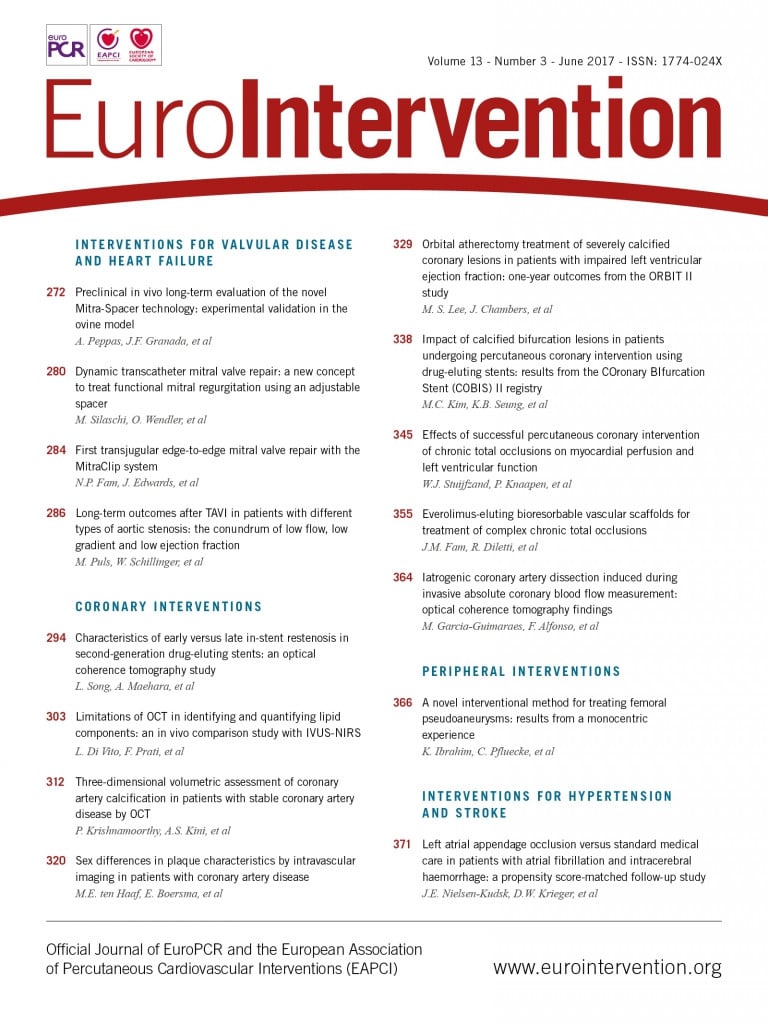

An 86-year-old woman presented with heart failure and persistent NYHA IV symptoms. Her past history included atrial fibrillation and pulmonary embolism with inferior vena cava filter. Transoesophageal echocardiography (TEE) demonstrated severe mitral regurgitatiton (MR) with P2 flail segment (Panel A-Panel C, Moving image 1). Transfemoral venous catheterisation was impossible due to venous occlusion. After Heart Team discussion, the patient’s surgical risk was deemed prohibitive and transjugular MitraClip® (Abbott Vascular, Santa Clara, CA, USA) implantation was planned.
Transseptal puncture was performed via the right internal jugular vein using the SupraCross™ system (Baylis, Montreal, Canada) (Panel D, Panel E, Moving image 2, Moving image 3). A mid-posterior septal position was selected, 4.2 cm above the mitral annulus. The MitraClip guide catheter was introduced clockwise with 180 degree rotation of the + knob for septal crossing (Panel F). The clip was inserted into the guide with a 90 degree counterclockwise rotation. Without straddling, the clip was navigated to the mitral valve using the + and P knobs (Panel G, Moving image 4). After deploying two clips, there was trace MR, with a mean gradient of 2 mmHg (Panel H-Panel J, Moving image 5). There were no complications and the patient’s condition improved, allowing discharge. Repeat echocardiography demonstrated sustained MR reduction.
In this first report, we demonstrate the feasibility of the transjugular approach for MitraClip implantation. The transjugular approach provides a more direct route to the mitral valve, and has been described for mitral valvuloplasty1 and mitral valve-in-valve replacement2. Other alternative access options for MitraClip implantation include direct right atrial puncture3 or a pulmonary venous approach via a right mini-thoracotomy4. In our case, we used a novel transseptal system that employs a steerable sheath and radiofrequency wire. Using a modified steering technique, we implanted two clips with sustained MR reduction.
When planning transjugular edge-to-edge mitral repair, several points should be considered. 1) The transseptal puncture should be superior and posterior for an optimal trajectory to the mitral valve, especially given the tendency of the sheath to move inferiorly. 2) The left atrium should be large enough to allow safe guide catheter steering. 3) Excessive guide manipulation should be avoided to prevent septal trauma. Larger studies of transjugular access for mitral edge-to-edge repair are required to confirm efficacy and safety compared to the transfemoral approach. Given the more direct route to the mitral valve, the transjugular approach may have applications for other transcatheter mitral repair or replacement devices.
Conflict of interest statement
The authors have no conflicts of interest to declare.
Supplementary data
Moving image 1. Preprocedural TEE demonstrating severe MR.
Moving image 2. Intraprocedural TEE of septal tenting with the SupraCross system.
Moving image 3. Fluoroscopy of transseptal puncture with the SupraCross system.
Moving image 4. Intraprocedural 3D TEE of the clip prior to grasping.
Moving image 5. Post-procedural TEE showing trace MR.
Supplementary data
To read the full content of this article, please download the PDF.
Preprocedural TEE demonstrating severe MR.
Intraprocedural TEE of septal tenting with the SupraCross system.
Fluoroscopy of transseptal puncture with the SupraCross system.
Intraprocedural 3D TEE of the clip prior to grasping.
Post-procedural TEE showing trace MR.

